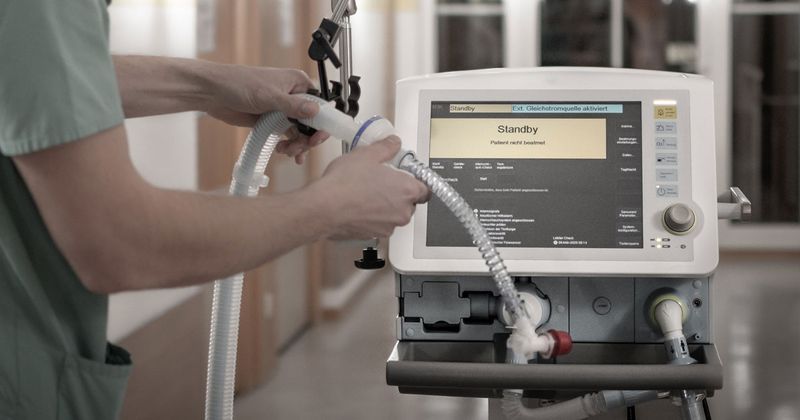Air hunger, psychological trauma an ‘urgent problem’ in ventilated COVID-19 patients
Ventilated patients with severe COVID-19 infection may experience air hunger and psychological trauma. A new paper published in the Annals of the American Thoracic Society calls attention to ventilation and medication strategies.
Air hunger — a feeling of severe breathlessness — is experienced by many ventilated patients wherein they are unable to breathe properly or voluntarily take a breath. Air hunger is caused by an increase in medullary respiratory drive extended to the cerebral cortex and is ameliorated by tidal inflation of the lungs, Christopher M. Worsham, MD, research fellow in the Harvard Medical School department of health care policy and the Massachusetts General Hospital and Beth Israel Deaconess Medical Center divisions of pulmonary and critical care medicine, and colleagues wrote.

When the drive to breathe is very high, as it might be with exercise or a respiratory infection like COVID-19, a person often develops a sensation of air hunger, or a strong urge to breathe as well as an increase in the number of breaths per minute and the size of the breath. Under these conditions, restricting the breath size can make the sensation of breathing discomfort worse, according to an ATS press release.
The authors reviewed recent reports of patients with severe COVID-19 infection admitted to ICUs in Italy, Seattle, New York City and Boston. Seventy-five percent to 88% of those patients were mechanically ventilated, and dyspnea prior to intubation and mechanical ventilation was a common symptom in 88% and 91% of patients with severe COVID-19 infection in the Seattle and Boston cohorts, respectively.
“With the likelihood that hundreds of thousands of dyspneic patients will require low tidal volume mechanical ventilation around the world, we are concerned about the potential for mass psychological trauma in the survivors induced by untreated air hunger during this pandemic,” Worsham and colleagues wrote.
‘Problem is not intractable’
According to Worsham and colleagues, air hunger “evokes fear and anxiety” among ICU and COVID-19 survivors. Prior research has demonstrated that the experience of air hunger is associated with PTSD in ICU survivors.
“The problem is not intractable, however. Physicians who are treating acute respiratory distress syndrome due to COVID-19, some of whom may not be accustomed to treating patients with respiratory failure, must first be aware of the problem and then consider means by which air hunger can be ameliorated,” Worsham and colleagues wrote.
However, some practices currently in use may be outdated or misguided.
Worsham and colleagues describe a mistaken belief that paralysis reduces breathlessness, which often results in treatment with neuromuscular-blocking drugs to minimize lung injury. According to the authors, this strategy “does not diminish air hunger.” Paralysis may exacerbate the problem and prevent the patient from effectively communicating or demonstrating their discomfort. Also, while patients are sedated, most sedatives studied have been shown not to relieve shortness of breath.
“In the Seattle [COVID-19] cohort, neuromuscular blockade was used in 39% of mechanically ventilated patients,” the researchers wrote. “Paralysis exacerbates the inherent challenges to managing dyspnea by eliminating most observable signs of the symptom.”
Opiates as a pharmacological intervention
Pharmacological interventions such as benzodiazepines and propofol have been shown to be ineffective for relieving dyspnea and are, thus, less likely to lessen air hunger symptoms and may exacerbate psychological trauma in patients with ARDS, according to the authors.
Worsham and colleagues point to opiates as “an easily accessible remedy with which most physicians are familiar.” Opiates “act both through depression of ventilatory drive and ascending perceptual pathways,” according to the authors.
In a 2011 study conducted in opiate-naive healthy patients, 5 mg of IV morphine “provided profound relief of experimentally induced air hunger,” Worsham and colleagues noted. Other studies have shown opiate relief of clinical dyspnea, even with low doses of opioids, they wrote.
During the COVID-19 pandemic, physicians are urged to consider the pharmacological benefits of opiates in treating ventilated patients with COVID-19 infection to relieve air hunger.
“There has been a tendency to equate ‘sedation’ with an ‘anti-dyspnea’ effect, and the push has been to use sedation primarily because patients are often anxious and agitated when being treated with mechanical ventilation,” Richard Schwartzstein, MD, chief of pulmonology, critical care and sleep medicine at Beth Israel Deaconess Medical Center and professor of medicine at Harvard Medical School, said in the press release. “We now know that many sedatives do not relieve dyspnea and we urge doctors to use opiates for dyspnea and sedatives, when needed, for anxiety and agitation.”

